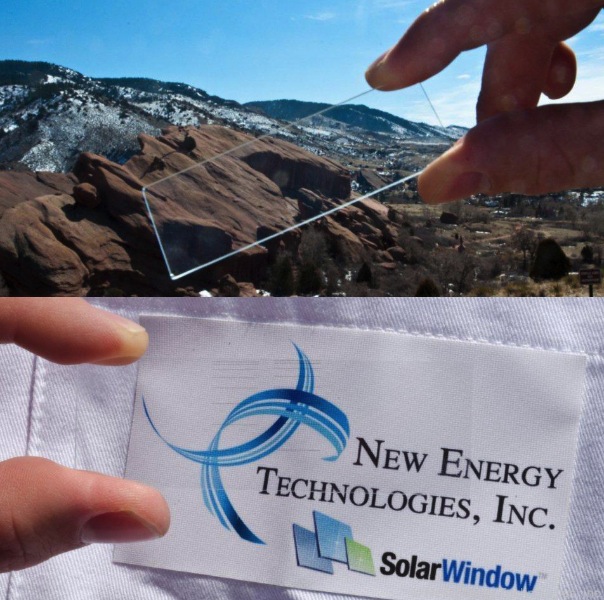SolarWindow tech gets the round 2 NREL research & development go-ahead
 New Energy Technologies and the National Renewable Energy Laboratory (NREL) are moving with research and development on the company’s transparent SolarWindow photovoltaic technology. New Energy Technology's SolarWindow technology consists of nano-particle spray, with PV cells that are smaller than a quarter of grain of rice and 1/1,00th the width of a human hair. Under the recently announced agreement, the two will collaborate on enhancing various performance features of the glass, including features like flexible applications for building-integrated PV (BIPV), to move the technology closer to commercialization.
New Energy Technologies and the National Renewable Energy Laboratory (NREL) are moving with research and development on the company’s transparent SolarWindow photovoltaic technology. New Energy Technology's SolarWindow technology consists of nano-particle spray, with PV cells that are smaller than a quarter of grain of rice and 1/1,00th the width of a human hair. Under the recently announced agreement, the two will collaborate on enhancing various performance features of the glass, including features like flexible applications for building-integrated PV (BIPV), to move the technology closer to commercialization.
The potential market for BIPV is huge—imagine a skyscraper or office building that generates power not only from roof-mounted PV, but also from invisible PV on southern-facing windows throughout the year. “There are nearly 5 million commercial buildings in the United States and an increasing demand for 'green' buildings. Driven by rising energy costs, increasing electricity consumption, government initiatives, and heightened consumer awareness, the demand for green construction and sustainable materials continues to rise,” New Energy Technologies said.
Under the recently signed Phase 2 of its Cooperative Research and Development Agreement (CRADA) with NREL, advance the development of its SolarWindow technology, capable of generating electricity on glass. Together, the organizations will work to enhance performance, processing and lifetime of the SolarWindow technology. They will also work to develop methods of deposition for various coatings on flexible surfaces like see-through and tinted plastics.
"This second phase of the CRADA emphasizes the Company's active commitment to develop the SolarWindow see-through electricity-generating coatings into commercially valuable building integrated products, with the assistance of world-class research teams at NREL," said J. Patrick Thompson, vice president, of Business and Technology Development for New Energy Technologies. "Naturally, we're pleased to continue our ongoing research and development relationship with NREL in Golden, Col. NREL is one of the world's most respected and advanced solar-photovoltaic research institutions."
The CRADA agreement allows both organizations to work together on their intellectual property—for instance, New Energy Technologies has 12 patents related to the technology—to work towards specific product development goals. They will work to improve the efficiency and transparency of SolarWindow technology, as well as optimize the current and voltage output, and develop high speed and large area roll-to-roll (R2R) and sheet-to-sheet (S2S) coating methods required for commercial-scale BIPV and windows.
The last item will be key to helping the technology move forward in commercial applications. "Company and NREL scientists jointly developed this CRADA to maintain focus on SolarWindow power production, large area and high speed coating equipment and methods, improving reliability and performance, and commercialization," said John Conklin New Energy CEO. "As we work towards commercialization, the market potential of deploying a readily-available and affordable see-through glass window capable of generating electricity continues to aggressively drive our product development efforts."
While the majority of PV produced today is for flat panel-type installations, if BIPV solar is able to be produced inexpensively it can help reduce a building’s energy footprint. As such numerous companies are working on transparent and flexible applications for solar like WYSIPS and others. Although some are looking at different types of applications—WYSIPS, for instance, is developing transparent solar for devices like smartphones and laptops.



